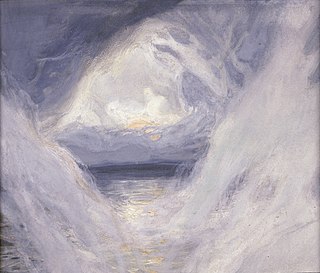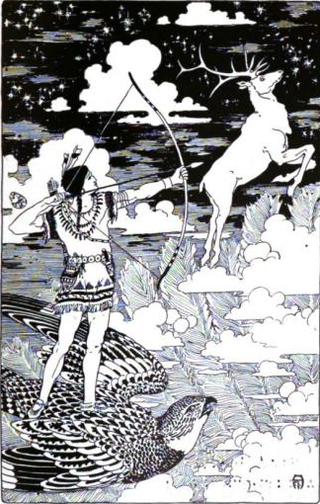Related Research Articles

A creation myth or cosmogonic myth is a type of cosmogony, a symbolic narrative of how the world began and how people first came to inhabit it. While in popular usage the term myth often refers to false or fanciful stories, members of cultures often ascribe varying degrees of truth to their creation myths. In the society in which it is told, a creation myth is usually regarded as conveying profound truths – metaphorically, symbolically, historically, or literally. They are commonly, although not always, considered cosmogonical myths – that is, they describe the ordering of the cosmos from a state of chaos or amorphousness.

In ancient Greek religion, Hera is the goddess of marriage, women, and family, and the protector of women during childbirth. In Greek mythology, she is queen of the twelve Olympians and Mount Olympus, sister and wife of Zeus, and daughter of the Titans Cronus and Rhea. One of her defining characteristics in myth is her jealous and vengeful nature in dealing with any who offended her, especially Zeus's numerous adulterous lovers and illegitimate offspring.

Mythology of the Haudenosaunee includes the creation stories and folktales of the Native Americans who formed the confederacy of the Five Nations Iroquois, later the Six Nations Iroquois Confederacy. Historically, these stories were recorded in wampum and recited, only being written down later. In the written versions, the spellings of names differ due to transliteration and spelling variations in European languages that were not yet standardized. Variants of the stories exist, reflecting different localities and times.
Diné Bahaneʼ, is a Navajo creation story that describes the prehistoric emergence of the Navajo as a part of the Navajo religious beliefs. It centers on the area known as the Dinétah, the traditional homeland of the Navajo, and forms the basis of the traditional Navajo way of life and ceremony. Throughout the stories the importance of cardinal points and the number four are emphasized in multiple aspects.
Seneca mythology refers to the mythology of the Onödowáʼga:, one of the six nations of the Haudenosaunee from the northeastern United States and Canada.
In Tongan mythology, or oral history, ʻAhoʻeitu is a son of the god ʻEitumātupuʻa and a mortal woman, ʻIlaheva Vaʻepopua. He became the first king of the Tuʻi Tonga dynasty in the early 10th century, dethroning the previous one with the same name but originating from the uanga (maggots) instead of divine; see Kohai, Koau, mo Momo.

Nut, also known by various other transcriptions, is the goddess of the sky, stars, cosmos, mothers, astronomy, and the universe in the ancient Egyptian religion. She was seen as a star-covered nude woman arching over the Earth, or as a cow. She was depicted wearing the water-pot sign (nw) that identifies her.

Nüwa, also read Nügua, is a mother goddess, culture hero, and/or member of the Three Sovereigns of Chinese mythology. She is a goddess in Chinese folk religion, Chinese Buddhism, Confucianism and Taoism. She is credited with creating humanity and repairing the Pillar of Heaven.

Twins appear in the mythologies of many cultures around the world. In some cultures they are seen as ominous, and in others they are seen as auspicious. Twins in mythology are often cast as two halves of the same whole, sharing a bond deeper than that of ordinary siblings, or seen as fierce rivals. They can be seen as representations of a dualistic worldview. They can represent another aspect of the self, a doppelgänger, or a shadow.

The Iroquois mythic hero Sosondowah was a great hunter known for stalking a supernatural elk, Oh-je-a-neh-doh. Sosondowah was captured by Dawn, a goddess who needed him as a watchman. He fell in love with Gendenwitha, a human woman. He tried to woo her by singing to her in spring as a bluebird, in summer as a blackbird and in autumn as a hawk, who then tried to take Gendenwitha with him to the sky. Dawn tied him to her doorpost and then changed Gendenwitha into the Morning Star, so he could watch her all night but never be with her.

The Three Sisters are the three main agricultural crops of various indigenous peoples of Central and North America: squash, maize ("corn"), and climbing beans. In a technique known as companion planting, the maize and beans are often planted together in mounds formed by hilling soil around the base of the plants each year; squash is typically planted between the mounds. The cornstalk serves as a trellis for climbing beans, the beans fix nitrogen in their root nodules and stabilize the maize in high winds, and the wide leaves of the squash plant shade the ground, keeping the soil moist and helping prevent the establishment of weeds.

Philippine mythology is rooted in the many indigenous Philippine folk religions. Philippine mythology exhibits influence from Hindu, Muslim, Buddhist, and Christian traditions.
Estonian mythology is a complex of myths belonging to the Estonian folk heritage and literary mythology. Information about the pre-Christian and medieval Estonian mythology is scattered in historical chronicles, travellers' accounts and in ecclesiastical registers. Systematic recordings of Estonian folklore started in the 19th century. Pre-Christian Estonian deities may have included a god known as Jumal or Taevataat in Estonian, corresponding to Jumala in Finnish, and Jumo in Mari.

Latvian Lauma or Lithuanian Laumė, or Yotvingian Łauma is a fairy-like woodland spirit, and guardian spirit of orphans in Eastern Baltic mythology or Yotvingian mythology. Originally a sky spirit, her compassion for human suffering brought her to earth to share our fate.
Atahensic, also known as Sky Woman, is an Iroquois sky goddess. Atahensic is associated with marriage, childbirth, and feminine affairs in general.

Turtle Island is a name for Earth or North America, used by some American Indigenous peoples, as well as by some Indigenous rights activists. The name is based on a creation story common to several Indigenous peoples of the Northeastern Woodlands of North America.

The mythology of Indonesia is very diverse, the Indonesian people consisting of hundreds of ethnic groups, each with their own myths and legends that explain the origin of their people, the tales of their ancestors and the demons or deities in their belief systems. The tendency to syncretize by overlying older traditions with newer foreign ideas has occurred. For example, the older ancestral mythology might be merged with foreign mythology, such as Hindu, Islam, or Christian biblical mythology.

Hé-no is a thunder spirit of the Iroquois and Seneca people. He is also known as Heno, Hino, Hinu or Hinun.

The Hero Twins are recurring characters from the mythologies of the indigenous peoples of the Americas. The specifics of each myth vary from tribe to tribe, but each story has a pair of twins who were born when their pregnant mother was killed by the tale's antagonist. Twins were considered unnatural in many cultures of this region, with beliefs about them having supernatural abilities.
References
- ↑ "Raweno (Ha-Wen-Neyu), the Iroquois Creator". www.native-languages.org. Retrieved 2020-04-28.
- ↑ Cotterell, Arthur. (1989). The illustrated encyclopedia of myths & legends. Sydney: Collins Australia. p. 204. ISBN 0-7322-0099-7. OCLC 27581076.
- ↑ Converse, Harriet Maxwell (Ya-ie-wa-no); Parker, Arthur Caswell (Ga-wa-so-wa-neh) (December 15, 1908). "Myths and Legends of the New York State Iroquois". Education Department Bulletin. University of the State of New York: 31–41. Retrieved Nov 9, 2014.
- ↑ Morgan, Lewis Henry (1995). The League of the Iroquois. J G Press. pp. 141–174. ISBN 1-57215-124-2.
- 1 2 Louellyn White (2015). Free to Be Mohawk: Indigenous Education at the Akwesasne Freedom School. University of Oklahoma Press. p. 29. ISBN 978-0-8061-5325-4.
- ↑ Lloyd, Ellen (September 23, 2019). "Birth Of Good And Evil In Iroquois Beliefs". AncientPages.com.
- ↑ Us, Kimberly (November 14, 2021). "Thanksgiving: Native American Stories, Recipes and Crafts". KimberlyUs.com.
- ↑ Day, Ashley (November 20, 2023). "3 Sisters to Invite to Thanksgiving". Food & Wine.